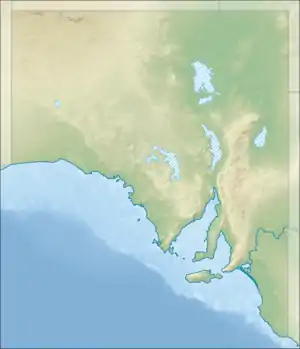| Lake Hawdon South Conservation Park Bray, South Australia | |
|---|---|
IUCN category VI (protected area with sustainable use of natural resources)[1] | |
 Lake Hawdon South Conservation Park | |
| Nearest town or city | Robe[2] |
| Coordinates | 37°13′13″S 139°56′40″E / 37.2203255319999°S 139.944499556°E[1] |
| Established | 18 February 2010[3] |
| Area | 31.85 km2 (12.3 sq mi)[4] |
| Managing authorities | Department for Environment and Water[4] |
| See also | Protected areas of South Australia |
Lake Hawdon South Conservation Park is a protected area located in the Australian state of South Australia in the locality of Bray about 280 kilometres (170 mi) south-east of the state capital of Adelaide and about 18 kilometres (11 mi) east of the town of Robe.[2]
The conservation park consists of crown land in Sections 177 and 178 of the cadastral unit of the Hundred of Bray. It came into existence on 18 February 2010 by proclamation under the National Parks and Wildlife Act 1972. On the same day, a separate proclamation ensured that “certain existing and future rights of entry, prospecting, exploration or mining” permitted under the state's Petroleum and Geothermal Energy Act 2000 would apply to the extent of the conservation park.[5] As of 2016, it covered an area of 31.85 square kilometres (12.30 sq mi).[2][4][3]
The conservation park's boundaries align with the extent of the water body known as Lake Hawdon South which was described in 2010 as a “shallow, seasonally inundated lake”, as having an area of about 31.9 square kilometres (12.3 sq mi) and which is the southern basin of a larger system known as Lake Hawdon. The lake contains extensive areas of sedgelands including species such as Gahnia trifida, Gahnia filum, Baumea arthrophylla, Baumea juncea and Juncus kraussii.[6]
In 2010, the conservation park's conservation significance was described as follows:[6]
- It supports biota of conservation significance including “17 vertebrate fauna species, seven plant species and three plant communities.”
- Two plant communities are considered vulnerable at a state and regional level, being the “Baumea juncea / B. arthrophylla sedgeland on the western side of the lake and Gahnia filum / G. trifida sedgeland.”
- It contains a field of microbial accretionary structures known as thrombolites which cover an area of 3.20 square kilometres (1.24 sq mi).
- It contains about 100 native fauna species including the western grey kangaroo, wombat and bush rat, eight amphibian species and 15 reptile species including the state endangered glossy grass skink.
The conservation park is classified as an IUCN Category VI protected area.[1]
See also
References
- 1 2 3 "Terrestrial Protected Areas of South Australia (refer 'DETAIL' tab )". CAPAD 2016. Australian Government, Department of the Environment (DoE). 2016. Retrieved 21 February 2018.
- 1 2 3 "Search results for 'Lake Hawdon South Conservation Park' with the following datasets selected – 'Suburbs and Localities', 'NPW and Conservation Properties' and 'Water Bodies'". Location SA Map Viewer. South Australian Government. Retrieved 15 April 2018.
- 1 2 "National Parks and Wildlife (Lake Hawdon South Conservation Park) Proclamation 2010". South Australian Government Gazette. South Australian Government. 18 February 2010. p. 838. Retrieved 22 March 2018.
- 1 2 3 "Protected Areas Information System Reserve List" (PDF). Government of South Australia. 14 December 2016. Retrieved 27 December 2017.
- ↑ "National Parks and Wildlife (Lake Hawdon South Conservation Park—Mining Rights) Proclamation 2010". South Australian Government Gazette. South Australian Government. 18 February 2010. p. 838. Retrieved 22 March 2018.
- 1 2 "Monitoring the Ecological Response of High Values Wetlands to Changes in Groundwater. Ecological Associates report CC017-2-A prepared for Department for Environment and Heritage, South Australia" (PDF). Ecological Associates. 15 January 2010. pp. 13-1 to 13-3. Retrieved 15 April 2018.